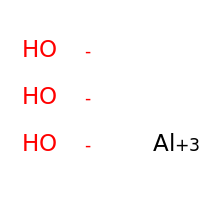
Aluminum hydroxide
| Chemical identification | |
|---|---|
| Pubchem identifier | 10176082 |
| CAS identifier | 21645-51-2 |
| IUPAC name | Aluminum hydroxide |
| Structure |  2D:2D MOL2D MOL22D SDF 3D:3D MOL3D MOL23D SDF3D PDB3D PDBQT |
| SMILES | [OH-].[OH-].[OH-].[Al+3] |
| InChI | InChI=1S/Al.3H2O/h;3*1H2/q+3;;;/p-3 |
| InChIKey | WNROFYMDJYEPJX-UHFFFAOYSA-K |
| Synonyms | AKP-DA; Alcoa 331; Alcoa 710; Alcoa A 325; Alcoa AS 301; Alcoa C 330; Alcoa C 331; Alcoa C 333; Alcoa C 385; Alhydrogel; Alolt 8; Alternagel; Alugel; Alugelibye; Alumigel; Alumina trihydrate; Aluminic acid (H3AlO3); Aluminium hydroxide; Aluminum hydroxide; Aluminum hydroxide (Al(OH)3); Aluminum oxide trihydrate; Aluminum trihydroxide; Aluminum(III) hydroxide; Alusal; Amorphous alumina; Amphogel; Amphojel; Antipollon HT; Apyral; Apyral 120; Apyral 120VAW; Apyral 2; Apyral 4; Apyral 8; Apyral B; Arthritis Pain Formula Maximum Strength; Ascriptin; BACO AF 260; British aluminum AF 260; Calcitrel; Calmogastrin; Camalox; Dialume; Gelusil; Higilite; Hychol 705; Hydrafil; Hydrated aluminum oxide; Kudrox; Liquigel; Maalox; Maalox HRF; Maalox Plus; Martinal; Mylanta; Simeco Suspension; Trihydrated alumina; Trihydroxyaluminum; Trisogel |
| External identifiers | D000536 |